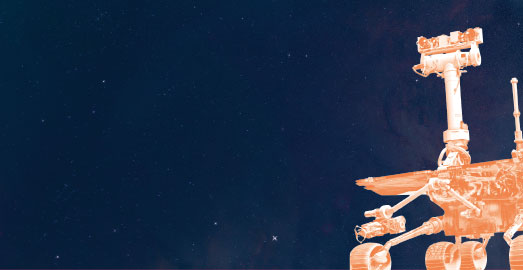If we are going to conquer the universe, we will need help from autonomous vehicles, such as the HDPR Mars Rover. They have to travel over unfamiliar terrain without the possibility of human intervention – and must sometimes show a little courage as well.
As an extension of humans out in the wider universe, intelligent robots can change the future of space travel in the long term. Largely autonomous vehicles will land on celestial bodies, explore them, and thereby accelerate the exploration of the Solar System. High mobility, precise manipulation and the durability and reliability of the robotic systems are crucial factors for success.
“Remote control is not possible on Mars. That’s why a self-navigating rover is viewed as an essential technology for future missions.”
Levin Gerdes, robotics engineer, ESA
Special conditions require special chips
However, this requires custom-adapted electronics because the environmental conditions in space are much tougher than on Earth. Extreme temperature fluctuations, radiation and high acceleration forces are just some of the loads affecting devices and components. Cosmic radiation in particular – solar wind and other charged particles from the galactic background – can cause structural damage to the chips’ crystal lattice and lead to errors in computing processes. In order to avoid this, the chips have to be constructed using different methods to their terrestrial counterparts: for example, the silicon substrate used for conventional chips is replaced with aluminium oxide. This is due to the fact that silicon, unlike aluminium oxide, can lose its insulating effect under the influence of cosmic radiation. However, because these “toughening” measures are expensive and the chips cannot be manufactured in current production plants, old tried-and-tested chips are still in use. For example, NASA’s standard spaceflight processor, the RAD750, is based on a PowerPC 750 processor that was introduced in 1998. Although it operates reliably in a temperature range between -55 and 125 °C, and is resistant to a total radiation dose of up to 200,000 rad, it is also very slow compared to present-day standards. Its maximum performance is 200 MHz. By way of comparison, a modern chip operates at a clock frequency of up to 5 GHz.
Spacecraft with eyes and a brain
Autonomous vehicles, however, require fast processors. For this reason, NASA’s Goddard Space Flight Center demonstrated a new processor technology back in 2009: the SpaceCube processor, which is faster than the RAD750 by a factor of 10 to 100. To achieve this, the Goddard engineers have combined radiation-resistant circuits, which perform specific computing tasks simultaneously, with algorithms that can detect and repair radiation-induced errors in the data. This system is almost as reliable as the RAD750, but due to its considerably higher speed, it is able to perform complex calculations that have hitherto been limited to terrestrial systems. The processor is used in the Raven module, for example: in the future, this system will enable supply carriers to dock autonomously with the ISS. To this end, Raven is equipped with camera, infrared and lidar sensors, as well as algorithms for machine vision. “The sensors serve as the eyes. SpaceCube acts as the brain, analysing data and telling components what to do,” says Ben Reed, Deputy Division Director of SSPD.

Humans can still intervene on the moon
These “toughened” chips are also essential for the rovers participating in the Google Lunar XPRIZE competition: the first privately funded team that succeeds in sending a rover approximately 400,000 kilometres to the moon, making it travel 500 metres, and having it transmit HD videos and images back to Earth by the end of 2017, will be awarded 20 million dollars. XPRIZE has recently confirmed that five teams have secured contracts to launch their spacecraft in 2017. Lunar vehicles such as the Tesla Prospector and Surveyor from the Synergy Moon Team are already able to perform basic autonomous functions. They can monitor themselves and carry out exploration missions autonomously. However, there is always the option of controlling them remotely from Earth.
Left to their own devices on Mars
“The Moon is close enough for direct remote control, albeit with a slight time delay,” explains robotics engineer Levin Gerdes from the European Space Agency (ESA). “But for Mars, the distance involved makes that impossible. Instead Martian rovers are periodically uploaded with sets of telecommands to follow. This is a slow process, however. A faster, self-navigating rover is seen as a necessary technology for future missions, like self-driving cars on Earth. But with no roads, the rover will have to work out its own route – first by taking images, then by using these to map the surrounding area, followed by identifying obstacles and planning a path to safely reach its assigned goal.” Gerdes proved that this is indeed possible with an ESA team in Tenerife in summer 2017: the Teide National Park provides a moon-like surface with sand and small boulders, enabling the ESA team to test the autonomous navigation of their Heavy Duty Planetary Rover (HDPR) under realistic conditions. With its seven cameras and sensor data from time-of-flight cameras, lidar and GPS systems, the vehicle actually managed to navigate on its own on the difficult terrain. “We managed a number of runs, the longest of which was more than 100 m – only for the rover to finally inform us that its assigned destination was unreachable, which turned out to be true. There were some slopes which were too steep to guarantee a safe traverse.”

Taking some bold decisions
But safety is not always the top priority: sometimes, a successful mission is considered more important than potentially damaging the hardware. An autonomous Mars Rover must therefore also dare to take risks. And this is precisely what the scientists working on the intelliRISK project want to teach their robots: they should be able to independently assess risks and consciously evaluate situations in order to make decisions. The project uses Lauron, a walking robot developed at the FZI Research Center for Information Technology at the Karlsruhe Institute of Technology, which is capable of moving safely on rough terrain. With its programmed courage, the robot must be able to detect, assess and consciously take risks when confronted with a steep slope or a wide ditch, for example. At the beginning of the mission, the robot may act with caution and restraint but later on, towards the end of its service life, it will be able to make bolder decisions. “The intelliRISK project is making an important contribution to increasing autonomy in the field of robotics,” says Arne Rönnau, who is responsible for the project. In addition to space travel, the system could also be used in other fields. “In the future, robotic risk awareness could also be used in Industry 4.0 applications in order to enhance occupational safety while working with humans and avoid accidents,” says the robotics expert.
